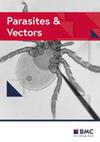A study on the diversity of phlebotomine sand flies (Diptera, Psychodidae) in karstic limestone areas in Vientiane Province, Laos, with a description of two new species of Sergentomyia França and & Parrot
IF 3
2区 医学
Q1 PARASITOLOGY
引用次数: 0
Abstract
Southeast Asia is well known as a hotspot of biodiversity. However, very little is known about cave-dwelling hematophagous insects that are medically important. Taxonomic knowledge and ecology of phlebotomine sand flies are very poorly studied in Laos, as well as in other countries in the region. Herein, we report species diversity data and some notes on the ecology of the detected species from these karstic limestone areas of Laos. Phlebotomine sand flies were collected using Centers for Disease Control and Prevention (CDC) light traps from limestone cave locations in three districts of Vientiane Province, Laos. Both morphological and molecular techniques were used for sand fly identification. Species diversity and abundance were analyzed according to sites, locations, collection seasons, and trapping positions. A total of 6564 sand flies, of which 5038 were females and 1526 were males, were morphologically identified into 20 species belonging to five genera (Chinius, Idiophlebotomus, Phlebotomus, Sergentomyia, and Grassomyia). The most abundant species were Chinius eunicegalatiae, Phlebotomus stantoni, Sergentomyia hivernus, Se. siamensis, and Idiophlebotomus longiforceps. Cytochrome b analysis results supported the morphological identification and revealed that Se. siamensis was separated from other members of the Se. barraudi group. Two new species, Se. dvoraki n. sp. and Se. marolii n. sp., were described. Sand fly density was generally high except in a cave in Vangvieng, with species richness ranging from 14 to 18 across different caves. Outside caves had higher species richness (R = 20) and diversity (H = 2.50) than cave entrances (R = 18, H = 2.41) and interiors (R = 16, H = 2.13). Seasonal variations showed high sand fly density in Feung and Hinheup during both dry and rainy seasons, while Vangvieng had a notable decrease in density during the dry season (D = 6.29). This study revealed that the diversity of phlebotomine sand fly fauna in Laos, particularly in karstic limestone areas, is greater than previously known. However, the taxonomic status of many species in Laos, as well as Southeast Asia, still needs more in-depth study using both morphological characters and molecular methods. Many species could be found from inside, at the entrance, and outside of caves, indicating a wide range of host-seeking behavior or possible natural breeding in the karstic cave areas.老挝万象岩溶石灰岩地区沙蝇(双翅目,灵蝇科)的多样性研究,并描述了 Sergentomyia França 和 & Parrot 的两个新种
众所周知,东南亚是生物多样性的热点地区。然而,人们对具有重要医学价值的穴居食血昆虫知之甚少。老挝以及该地区其他国家对血沙蝇的分类学知识和生态学研究非常少。在此,我们报告了老挝喀斯特石灰岩地区发现的物种多样性数据和一些生态学说明。我们使用美国疾病控制和预防中心(CDC)的灯光诱捕器从老挝万象省三个地区的石灰岩洞穴中收集了沙蝇。采用形态学和分子技术对沙蝇进行鉴定。根据地点、位置、采集季节和诱捕位置对物种多样性和丰度进行了分析。经形态学鉴定,共有 6564 只沙蝇,其中 5038 只为雌蝇,1526 只为雄蝇,隶属于 5 个属(Chinius 属、Idiophlebotomus 属、Phlebotomus 属、Sergentomyia 属和 Grassomyia 属)的 20 个种。数量最多的物种是 Chinius eunicegalatiae、Phlebotomus stantoni、Sergentomyia hivernus、Se. siamensis 和 Idiophlebotomus longiforceps。细胞色素 b 分析结果支持形态学鉴定,并表明 Se. siamensis 与 Se. barraudi 群的其他成员是分开的。描述了两个新种:Se. dvoraki n. sp.和 Se. marolii n. sp.。除万维翁的一个洞穴外,其他洞穴的沙蝇密度普遍较高,不同洞穴的沙蝇物种丰富度在 14 至 18 种之间。洞穴外的物种丰富度(R = 20)和多样性(H = 2.50)高于洞穴入口(R = 18,H = 2.41)和洞穴内部(R = 16,H = 2.13)。季节变化显示,在旱季和雨季,Feung 和 Hinheup 的沙蝇密度都很高,而 Vangvieng 的沙蝇密度在旱季明显下降(D = 6.29)。这项研究表明,老挝(尤其是喀斯特石灰岩地区)噬血沙蝇动物群的多样性比以前已知的要高。然而,老挝乃至东南亚许多物种的分类地位仍需要利用形态特征和分子方法进行更深入的研究。许多物种在洞内、洞口和洞外都能找到,这表明它们在喀斯特洞穴地区有广泛的寻找寄主行为或可能的自然繁殖。
本文章由计算机程序翻译,如有差异,请以英文原文为准。
求助全文
约1分钟内获得全文
求助全文
来源期刊

Parasites & Vectors
医学-寄生虫学
CiteScore
6.30
自引率
9.40%
发文量
433
审稿时长
1.4 months
期刊介绍:
Parasites & Vectors is an open access, peer-reviewed online journal dealing with the biology of parasites, parasitic diseases, intermediate hosts, vectors and vector-borne pathogens. Manuscripts published in this journal will be available to all worldwide, with no barriers to access, immediately following acceptance. However, authors retain the copyright of their material and may use it, or distribute it, as they wish.
Manuscripts on all aspects of the basic and applied biology of parasites, intermediate hosts, vectors and vector-borne pathogens will be considered. In addition to the traditional and well-established areas of science in these fields, we also aim to provide a vehicle for publication of the rapidly developing resources and technology in parasite, intermediate host and vector genomics and their impacts on biological research. We are able to publish large datasets and extensive results, frequently associated with genomic and post-genomic technologies, which are not readily accommodated in traditional journals. Manuscripts addressing broader issues, for example economics, social sciences and global climate change in relation to parasites, vectors and disease control, are also welcomed.
 求助内容:
求助内容: 应助结果提醒方式:
应助结果提醒方式:


